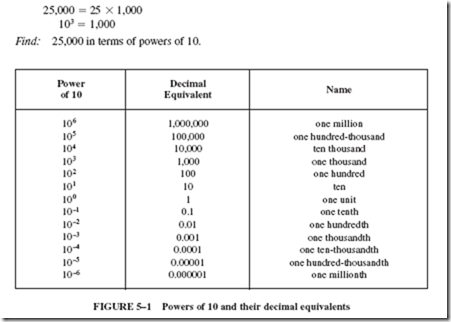Scientific Notation and Metric Prefixes
5–1 RATIONALE FOR STUDYING THIS UNIT
Personnel working in the field of electricity and electronics are frequently called upon to perform mathematical calculations in order to predict or confirm proper circuit operation. The numbers involved in such calculations are often extremely large or extremely small. For example, you may remember the electrical unit coulomb (defined in Section 4–3), consisting of 6,250,000,000,000,000,000 electrons. Many people feel ill at ease about pronouncing such numbers, let alone manipulating the numbers by multiplication or division.
For more than a generation, electrical technicians made use of a tool known as the slide rule, which requires knowledge and application of the powers of 10 principle. The invention and widespread use of modern electronic calculators has not relieved us of this need to manipulate numbers in scientific notation. In fact, the ability of a handheld
calculator to process and display very large (or very small) numbers depends on the use of scientific notation.
It is assumed that all students of this chapter will use an electronic calculator in working out the various exercises. If you own a calculator but do not fully understand all of its operations, you should consult your calculator’s instruction manual or seek help from someone within your study group.
A word of encouragement: If the topics of this chapter are new to you and you suffer frustration in your attempt to solve the assigned problems, do not despair! You are not expected to become an expert at this merely by finishing just one more chapter. The proficiency will come after repeated exposure to the ideas and principles presented here. You may have to refer back to this chapter many times as you progress in your studies.
5–2 POWERS OF 10
Surely, you know that 102 means 10 3 10, or 100. Likewise, 103 means 10 3 10 3 10 5 1,000, and so forth. Armed with this knowledge, you should easily construct a chart like the one shown in Figure 5–1.
Let us work a few examples to show how this knowledge can be used to express any number of powers of 10.
EXAMPLE 5–1
Given:
5–3 SCIENTIFIC NOTATION
The term scientific notation refers to a special way of using powers of 10. The method demands that a decimal point be placed behind the first significant digit when the number is changed into powers of 10. Let us use Example 5–4 to demonstrate this principle.
In fact, we have many more ways to write our answer. Here is a list of alternatives.
Of these choices, only the last number qualifies as scientific notation, because the decimal point appears behind the first significant digit.
Suggested Procedure
Count the number of spaces that the decimal point has to be moved in order to appear behind the first digit. This count, the number of spaces moved, becomes your exponent in the power of 10.
Let us express the number 6,750.0 as scientific notation. Note that the decimal point must be moved three places to the left in order to appear behind the numeral 6. The three places moved determines the exponent. Thus, we write our answer
6.75 x 103


![image_thumb[1] image_thumb[1]](http://lh6.ggpht.com/-lzPYY5cMOa8/VKl_kV2H2nI/AAAAAAABAN4/kuryrzM15Nc/image_thumb%25255B1%25255D_thumb.png?imgmax=800)
![image_thumb[2] image_thumb[2]](http://lh4.ggpht.com/-VUJIMw4_v1w/VKl_nQHVO0I/AAAAAAABAOI/sK1hgWRROJA/image_thumb%25255B2%25255D_thumb.png?imgmax=800)
![image_thumb[3] image_thumb[3]](http://lh4.ggpht.com/-YoLj6HTV6Ow/VKl_qcsNzPI/AAAAAAABAOY/agu7kcfGp2M/image_thumb%25255B3%25255D_thumb.png?imgmax=800)